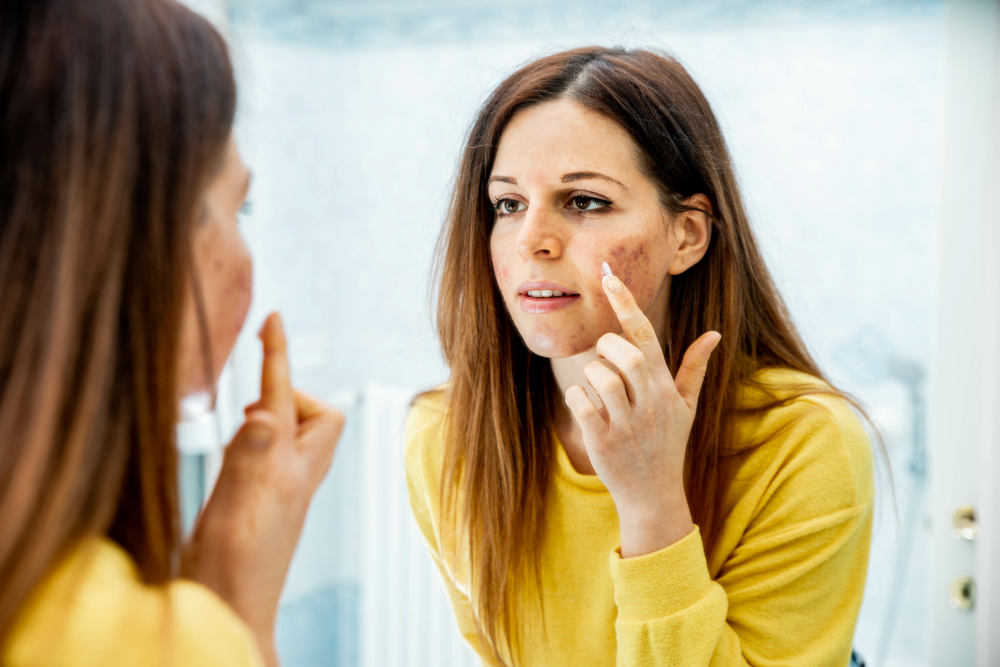Melasma is a chronic skin condition that causes changes in skin’s pigmentation (skin tone), and it can be one of the most challenging skin conditions to manage. According to Dr. Jennifer Holman of U.S. Dermatology Partners Tyler, “Melasma causes hyperpigmentation or darker patches of skin. While this condition is benign, it can be embarrassing. Many of my patients prefer to diminish the appearance of these dark spots. Treating melasma is notoriously difficult. Recent research shows that individuals may have greater control over the appearance of melasma than expected. Specifically, they can improve melasma treatment by taking steps to address the effects of alcohol consumption and other lifestyle factors that may trigger flareups.” In this blog, Dr. Holman reviews recent clinical studies that link alcohol consumption to increased melasma flareups as well as providing general information about causes and effective treatment options for this skin condition.
What Is Melasma?
So, what is melasma? It’s a chronic, inflammatory skin condition, but it’s unique compared to other skin health concerns that are linked to inflammation. Dr. Holman says, “Melasma creates dark patches of skin when certain internal or environmental aggressors stimulate melanocytes, the skin cells responsible for producing melanin (pigment).” Melasma usually causes brown to darker gray or even black patches of skin. In almost all cases, melasma develops on the cheeks, forehead, and nose. However, these patches of hyperpigmented skin may appear on any part of the face as well as on other parts of the body, especially following frequent or prolonged sun exposure in those areas. Although melasma is not harmful, its cosmetic impact can severely affect a person’s self-esteem, so it’s important to discuss prevention, management, and treatment options with a dermatologist.
Common Warning Signs of Melasma Include:
- Symmetrical, discolored patches across the face
- Worsening areas of pigmentation after sun exposure
- Occasional skin sensitivity or dryness in affected areas
Common Causes and Triggers of Melasma
When it comes to understanding risk for developing melasma, Dr. Holman says, “This is a condition that anyone can experience. However, it is significantly more common in women of color compared with other demographics. Darker skin tone, hormonal fluctuation, and living in warm climates are some of the biggest risk factors. Additionally, I frequently see this condition in pregnant patients. In fact, it’s so common for expecting mothers, that the nickname for melasma is the mask of pregnancy.”
The most frequent melasma causes and triggers include:
- UV exposure – Ultraviolet (UV) radiation from the sun is the most significant external trigger for melasma flareups. Sun damage activates melanocytes (the pigment-producing cells) to produce more melanin, darkening the skin.
- Hormonal changes – as previously mentioned, pregnancy is one of the most common triggers for melasma. Additionally, use of hormonal contraceptives, hormone replacement, and other shifts in hormone production can disrupt the hormonal balance, leading to the overproduction of melanin.
- Genetics – some individuals inherit a predisposition that makes skin more reactive to hormonal changes and UV light, causing them to be more likely to develop melasma.
- Medications – some prescription medications, like anti-seizure drugs, are known to make skin more sensitive to sun exposure, increasing the likelihood of melasma.
- Lifestyle factors – this is a new area being studied for potential correlation with melasma triggers. Specifically, alcohol consumption, caffeine intake, and smoking have been shown to potentially increase risk for the development or worsening of melasma. Among these, drinking alcohol has stood out in trials as a potential trigger.
Alcohol and Melasma: What the Research Says
On February 25, 2025, Dermatology Times published an evaluation of findings from a 2023 study conducted at Jiangsu Province Hospital of Chinese Medicine. This case control study explored the relationship between alcohol and melasma as well as other lifestyle factors that may impact the development and management of melasma. While there were many factors studied, alcohol intake seemed to be identified as a novel trigger for melasma. Specifically, the findings showed that alcohol consumption may worsen melasma in several different ways, including:
Liver Dysfunction
Alcohol is processed through the liver, but this organ is also vital in the metabolization of hormones. Excessive, prolonged, and chronic alcohol consumption damages the liver, making it more difficult for the body to metabolize hormones. This can lead to excessive levels of hormones in the body that trigger melanocytes to produce more melanin.
Oxidative Stress
Alcohol induces oxidative stress, which inflames skin, leading to hyperpigmentation and many other concerns. Oxidative stress occurs when the number of free radicals (highly charged, unpaired molecules) outweigh antioxidants. This causes free radical or oxidative damage that is responsible for numerous issues related to skin’s health and appearance, including accelerating the development of fine lines and wrinkles and causing hyperpigmentation.
Dehydration
Moisture is an essential element in skin’s barrier defense system. When skin cells are dehydrated, there are large gaps in the protective barrier, and cells are more likely to be damaged, leading to inflammation and triggering melasma. Alcohol is a diuretic. That means it can cause dehydration. Regular alcohol consumption may dry out skin, leaving it vulnerable.
Some General Study Conclusions
According to Dr. Holman, “Many of my patients ask does alcohol affect skin health? As a dermatologist, I have always understood that developing good health habits is important to keep skin healthy. This study confirms that alcohol consumption, especially regular or excessive drinking, is very likely to make managing melasma more difficult. For my patients struggling with melasma, I emphasize the importance of making healthy choices in all aspects of their lives to support melasma management.”
What Dermatologists Recommend to Prevent and Manage Melasma
When it comes to preventing and managing melasma flareups, Dr. Holman says, “Determining how to treat melasma begins with a focus on alleviating symptoms. Thanks to research and clinical studies, we have a greater understanding of the underlying causes, triggers, and risk factors related to melasma. The longer dermatologists have studied melasma, the more we have recognized the importance of addressing all the factors that contribute to the development of this condition. From preventing sun damage to reducing alcohol consumption, there are many small daily changes that improve outcomes when performed in conjunction with an effective skincare plan.” Below, Dr. Holman outlines the top dermatologist recommendations for preventing and managing melasma:
Avoid Known Triggers
If you know your triggers, take steps to avoid them. If you’re not sure what triggers your melasma flareups, take notes each day of weather, food and drinks you consume, medications, clothing, stress levels, and any other variables and how they impact melasma symptoms. Making brief daily notes for a few weeks is a great way to uncover your specific triggers. Some common triggers to avoid include:
- Heat – warm, humid areas like hot tubs and saunas can trigger melasma flareup.
- Sun – warm or cold, the sun’s UV rays can damage skin and trigger melasma symptoms.
- Hormonal imbalance – work with a medical professional to address any hormonal imbalances to reduce risk for melasma flareups.
- Alcohol consumption – drink less alcohol, and if possible, cut alcohol out completely.
Use Broad-Spectrum SPF Daily
Sun exposure is the leading trigger of melasma flareups. It’s recommended to reduce time in the sun, especially during peak hours between 10 am and 4 pm. However, you should also apply a broad-spectrum sunscreen with an SPF of 30 or higher daily and reapply at least every two hours, especially when outdoors. Physical sun blocks that use minerals like zinc oxide and titanium dioxide are usually the safest option as they create a physical barrier over skin. Chemical sunscreens are absorbed into skin, which can cause inflammation and irritation that could trigger or worsen a melasma flareup.
Consider Antioxidant-Rich Skincare
Oxidative damage is one of the leading triggers for melasma. Antioxidants counteract oxidative damage, so including more antioxidants in your daily routine can minimize risk for melasma flareups. Look for products that contain vitamin C, ferulic acid, and niacinamide.
Stay Hydrated and Eat a Balanced, Skin-Supportive Diet
In addition to a correlation between alcohol consumption and melasma flareups, research indicates that other daily choices like the foods we eat and drinking enough water also contribute to melasma management. To minimize risk, drink plenty of water, incorporate antioxidant-rich foods (leafy greens and fish), and avoid inflammatory foods and drinks (processed foods, sugar, and alcohol).
Treatment Options for Melasma
Melasma does not necessarily require treatment. However, Dr. Holman says, “My patients typically choose to address melasma for one of two reasons. The first and most common is that the noticeable dark spots on their face make them feel self-conscious. Others want to address the underlying triggers of melasma, like hormonal imbalance or sun damage, in order to prevent more serious health issues from developing. I work with patients to understand their goals and help them develop a personalized plan that may include topical treatments, in-office procedures, and cooperation with other specialists.”
Dermatologist-Recommended Topical Treatments
- Hydroquinone – originally considered the gold-standard for skin-lightening, hydroquinone is still recommended for short-term use in lightening small, dark spots. This topical treatment is not appropriate for long-term use.
- Tranexamic acid – topical treatments with this active ingredient are used to address stubborn dark spots.
- Retinoids – derived from vitamin A, retinoids accelerate cell turnover and fade dark spots when used consistently.
In-Office Procedures
- Chemical peels – these dermatologic treatments use acids to remove damaged skin cells, which lightens dark patches as healthy, new skin is revealed.
- Laser treatments – these procedures allow dermatologists to precisely target hyperpigmented areas and remove darker skin cells. However, it’s important to use these therapies with caution as laser therapy can also trigger hyperpigmentation in some.
- Microneedling – small injuries are made in the skin to stimulate the healing process and promote the production of collagen. As skin heals, hyperpigmented areas are replaced with healthy, new skin that blends more closely with the natural skin tone.
Lifestyle Changes
- Reduce alcohol consumption.
- Limit caffeine and avoid smoking.
- Avoid hot environments that trigger vascular changes and pigmentation.
Schedule a Dermatology Consultation
Addressing lifestyle triggers for melasma, like alcohol consumption, could make a noticeable difference in your skin’s clarity and overall health, but if you’re struggling with melasma or have other concerns about pigmentation changes, consult a dermatologist to create a personalized treatment and management plan. To get started with a local U.S. Dermatology Partners practice, take a few moments to complete our scheduling request form online. Once we receive your request, a team member will reach out to confirm.
Find a location near me
or


